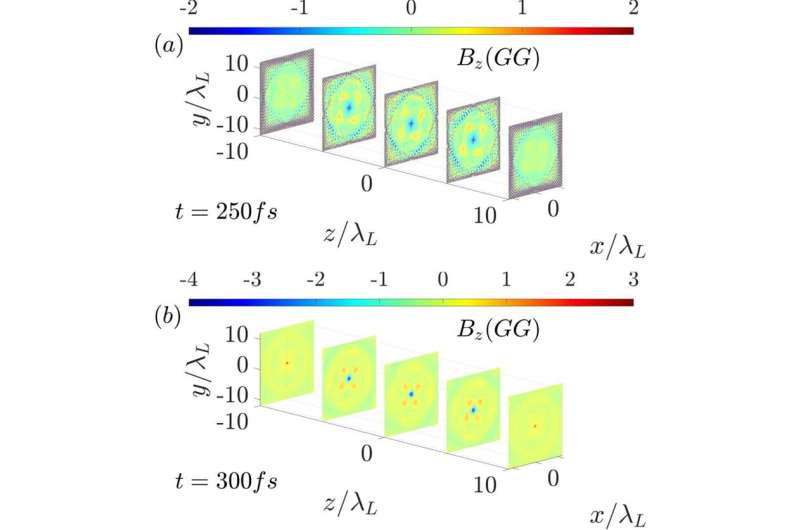Magnetic fields are detected throughout the universe and widely participate in astrophysical dynamics. Various fundamental phenomena, including coronal mass ejections, solar flares, gamma-ray bursts and pulsar winds, are dominated by variations in magnetic fields. Although the mechanisms involved in the origin of magnetic fields in space are still uncertain, one of the widely accepted plausible scenarios is the turbulent dynamo, which amplifies weak magnetic fields. Recent numerical studies and experiments with long pulse laser-produced colliding plasma flows have demonstrated the capability of seed field amplification. Coupling strong magnetic fields and high-power lasers supports cutting-edge research in laboratory astrophysics and laser-driven charged particle accelerations. With moderate laser intensities and a relatively long pulse length, mega-gauss (MG) magnetic fields in plasmas at the edges of focal spots have been achieved. Numerical and theoretical studies predict a magnetic field strength of 100 MG, while state-of-the-art experimental results are about 10 MG.
Recently, scientists at Osaka University investigated the mechanism of magnetic field growth from a weak seed field in a so-called 'microtube implosion' scenario and demonstrated a three order of magnitude amplification from MG- to GG-order magnetic fields via kinetic simulations. The obtained magnetic field strength is even stronger than that of pumping electromagnetic fields. Such high magnetic fields are comparable with astrophysical bodies like neutron stars and black holes. Besides, depending on the strength of the seed magnetic field and the target structure, the polarity of the resultant magnetic field is found to turn over instantly.
The magnetic field amplification process can be separated into the following three stages. The first is laser-driven implosion, in which hot electrons and imploded ions gain energy from pumping pulses. The second is the trapping of electrons, in which the electron angular momentum is converted to induce a magnetic field. As the number of injected and trapped electrons increases, the induced magnetic field is amplified. The third stage is dissipation of the induced magnetic field, in which the magnetic field energy is transferred to the angular momentum of the inner ions. The strength of the magnetic field decays as the ions expand. Although the growth and amplification of the magnetic field are mainly dominated by electron dynamics, the lifetime of the magnetic field is determined by the ion motion from collapse to explosion. The size of the field is of the order of tens of microns, and its lifetime lasts hundreds of femtoseconds.
The study conducted by Yan-Jun Gu and Masakatsu Murakami has confirmed that current laser technology can realize GG-order magnetic fields based on this concept. The presented concept and theoretical scaling laws for generating GG- order magnetic fields will be beneficial to pioneering fundamental research in various regions, including materials science, quantum electrodynamics (QED), and astrophysics, as well as other cutting-edge practical applications.
More information: Yan-Jun Gu et al, Magnetic field amplification driven by the gyro motion of charged particles, Scientific Reports (2021). DOI: 10.1038/s41598-021-02944-2
Journal information: Scientific Reports
Provided by Osaka University
























